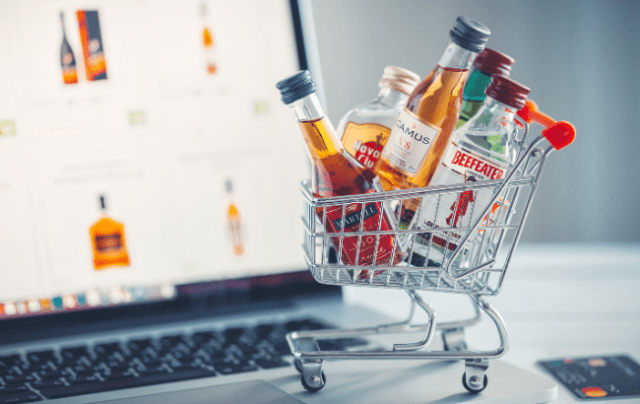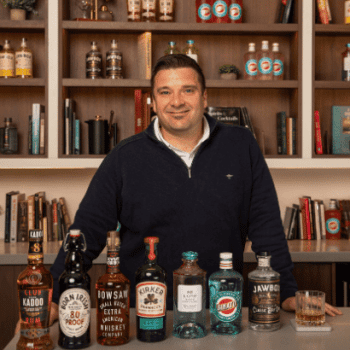Finding distribution success: on-shelf vs online
By Rupert HohwielerE-commerce has forever changed the way the spirits industry handles distribution, but is physical retail still the best route to market for newer brands?

According to IWSR’s Ecommerce Strategic Study, online alcohol sales in 18 global markets are expected to surpass US$36 billion by 2028, driven by agave spirts and whisky.
However, when it comes to achieving success, do newer brands stand a better chance by going through the traditional physical routes to market, battling for real estate on store shelves, or via online platforms where space is almost unlimited?
The increasing prevalence of direct-to-consumer (DTC) options is something that smaller brands are turning to in order to gain access to consumers, subsequently side-stepping the restrictions that being in a physical store can bring.
Drinksology Kirker Greer‘s (DKG) chief commercial and strategy officer Ryan McFarland argues that neither option is preferred over the other, with clear benefits to both. “Whether it’s from a branded website, or through someone like Master of Malt or Spiritly, this avenue allows brands to build up loyalty,” he tells The Spirits Business. “Being to be able to supply products directly to consumers’ homes, allowing them to buy them at a time when they want to buy them – it’s important.”

DKG has its own DTC business with Spiritly, which lists more than 5,000 products.
McFarland says Spiritly supplies consumers directly to their homes all across the UK, and sees “orders that come in 24 hours a day and are processed within 24 or 48 hours, depending on the location.
“What we have in that sphere is we open the opportunity for choice, which just doesn’t happen in traditional retail. A retailer can’t hold 5,000 products, or source products from all over the world and be prepared to hold them in small quantities.
“Today, the online world provides opportunities for smaller brands, in a way which may not always be available to them through traditional means.”
Benefits to traditional retail
Chris Seale, managing director of Specialty Brands, a distributor of premium spirits, also acknowledges the role both online and offline play in deciding the consumer experience.
“Obviously, physical retail is constrained by the physical dimensions of a store, and space tends to be more of a premium, whereas e-commerce has greater ranging ability.”
Speaking to The Spirits Business on the pros of securing e-commerce listings for brands, he says the online space is “particularly suited to servicing consumers ongoing needs for products they know,” while for physical retail, in contrast, “it’s built more around discovery and convenience.
“A lot of consumers, particularly if they’re spending £100-plus in a category, want to go into a store. They want to talk to someone. They want to feel and see the product first hand,” he adds.
Seale feels as though retail, or specifically independent retail, can offer a win for products that play in the premium space and offer a point of difference, looking to appeal to the discerning customer. He continues: “It’s really important in the premium and super-premium categories, and that’s where retail can really demonstrate a point of difference and really add value. I think competing on commoditised lines with supermarkets or with e-commerce is very difficult for them.”
Another benefit to independent retail, specifically for products with prices north of £100 (US$130), is the consumers’ ability to physically hold the product they’re about to buy.
Seale says: “A lot of independent retailers offer tasting facilities. My team and I are around every week in independent retail, doing tastings, doing masterclasses, and again that really helps on the selling side. Whereas, you don’t necessarily have that luxury so much on e-commerce.”

DKG says it designs brands that are deliberately built to ‘pop’ on shelves, so the company understands the gains of being in physical retail. However, it is also able to connect consumers to brands – and vice-versa – in a way that can only be done via its Spiritly platform.
McFarland explains that “if you go to spiritly.com, what you’ll find is something that is built as a brand. So Spiritly: the brand. What we’re working hard to do is make sure – if you want to call us a retailer or even a distributor – is that people actually trust the brand. And that’s a slightly different approach. So consistent visual brand cues about Spiritly, very consistent ways of packaging and ways of communicating with customers. That’s about making sure that we’re providing the choice, providing the service, and building the trust.
“As a brand owner, we work with traditional retailers and suppliers, and as the provider, we work with lots of different brands to connect their consumers. There’s a lot of brands that want to work with us because we can bring their consumers to their brands, and they can’t necessarily do that through traditional retail.”
Trust issues
While e-commerce has become more popular, especially since Covid, the hand-sale aspect of physical retail makes it a continually important channel within premium spirits in terms of trust – not about the product itself, but about the logistics side, Seale explains.
“It’s not just purely about not trusting e-commerce and delivery of glass through the post. It’s much more about the physical delivery of glass through the supply chain, whereas if you’re going into a store, it’s going to be in your bag, looked after, there and then.”
Regarding Spiritly and building this trust with its consumers, McFarland says: “We were really clear what we needed to have.
“Why would someone go online to Spiritly rather than go to their normal retailer? Well, because there’s a choice that they can’t get in the normal retailer. And why would they come back to us? Because the service you provide is at the highest level, and if they have choice and service, what happens? They build trust in the brand because we deliver what they want.
“That’s how we’ve orientated our mindset, doing things like ensuring that we’ve got purpose-built packaging to make sure that our breakage level is at the lowest possible level; making sure that all of our packaging is sustainable and that we put videos on our website so people can see our packaging before they order.
“We talk about our Trustpilot rating. We used that and we’ve got a 4.9 rating because breakages don’t happen, or very rarely happen. Things like this create trust with the consumer, so that when they place an order, they trust the brand that they’re buying from, i.e Spiritly, not just the product that they’re buying. As an online retailer you have to focus on that, otherwise you never get past the barrier to purchase.”
Ultimately, on what works best between on-shelf and e-commerce, it comes down to brand ambitions and where it sits in its lifestyle, McFarland maintains.
“Retailers shelves are not elastic and ranging is often highly contested, and although physical availability is prized, it’s not the only way to connect to consumers. We’ve found many smaller or newer brands, even when part of scale brand owner portfolios, find direct-to-consumer through their own sites or via partners like Spiritly.com are viable ways to connect both as they enter but also as they mature in market.
“With lower barriers to entry and an ability for more targeted communication, DTC can complement physical distribution for brands serious about succeeding in the market.”
Related news
Auténtico Nativo expands US distribution
Southern Glazer’s: data insights into distribution in the US
